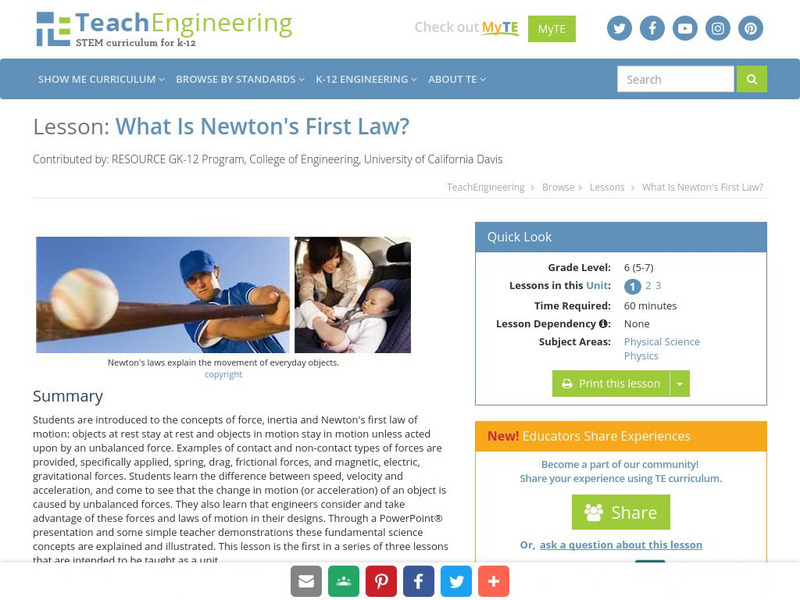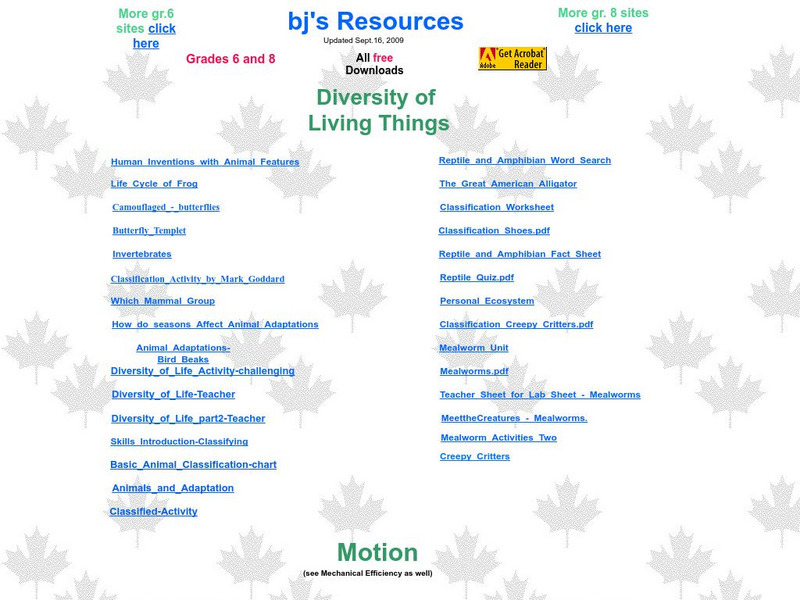Physics Classroom
The Physics Classroom: Motion and Forces in Two Dimensions: Vectors/direction
The emphasis of this unit is to understand some fundamentals about vectors, and to apply the fundamentals in order to understand motion and forces that occur in two dimensions.
Physics Classroom
The Physics Classroom: Motion and Forces in Two Dimensions: Vector Resolution
In this unit, students learn two basic methods for determining the magnitudes of the components of a vector directed in two dimensions. The two methods of vector resolution students will examine are the parallelogram method the...
TeachEngineering
Teach Engineering: Energy of Motion
By taking a look at the energy of motion all around us, students learn about the types of energy and their characteristics. They first learn about the two simplest forms of mechanical energy: kinetic and potential energy, as illustrated...
Wikimedia
Wikipedia: Centripetal Force
Wikipedia's site on centripetal force provides a section explaining the difference between centripetal force and centrifugal force. Includes formulas and hyperlinked terms.
Science Education Resource Center at Carleton College
Serc: Investigating Projectile Motion: Creating a Catapult
This activity is for 9th grade physical science students. It begins with an inquiry-based activity using a projectile motion computer simulation. It culminates with students building a catapult; applying and connecting science knowledge...
Middle School Science
Middle School Science: Motion Notes
Personal site in which a teacher outlines a unit on motion. Probes through topics such as average speed, velocity, acceleration, speed, deceleration, force and more.
Alabama Learning Exchange
Alex: Experiencing Newton's Laws of Motion
This lesson will approach the study of Newton's 3 Laws of Motion using McGraw-Hill Science textbook Unit F. The students will be given an overview of the laws and vocabulary words to study. After introducing and explaining the concept of...
TeachEngineering
Teach Engineering: What Is Newton's First Law?
Learners are introduced to the concepts of force, inertia, and Newton's first law of motion: objects at rest stay at rest and objects in motion stay in motion unless acted upon by an unbalanced force.This lesson is the first in a series...
TeachEngineering
Teach Engineering: Sliding Textbooks
In this culminating activity of the unit which highlights how forces play a role in engineering design and material choices, students explore and apply their knowledge of forces, friction, acceleration, and gravity in a two-part experiment.
TeachEngineering
Teach Engineering: Up, Up and Away! Airplanes
The airplanes unit begins with a lesson on how airplanes create lift, which involves a discussion of air pressure and how wings use Bernoulli's Principle to change air pressure. Following the lessons on lift, students explore the other...
TeachEngineering
Teach Engineering: The Force of Friction
In the first of two lessons of this curricular unit, students are introduced to the concept of friction as a force that impedes motion when two surfaces are in contact. Student teams use spring scales to drag objects, such as a ceramic...
ClassFlow
Class Flow: Forces in Action
[Free Registration/Login Required] In this unit children apply their knowledge of a variety of forces to contexts in which objects are stationary because forces on them are balanced. Children learn about the changes in motion which occur...
TeachEngineering
Teach Engineering: Mechanics Mania
Through ten lessons and numerous activities, students explore the natural universal rules engineers and physicists use to understand how things move and stay still. Together, these rules are called "mechanics." The study of mechanics is...
My Science Site
Life Systems: Cells, Tissues, Organs
Extensive site for teachers provides some helpful resources that pertain to plant and animal cells. Includes a microscope diagram as well as plant, animal and pond labs. Also contains links to structures and mechanisms, matter and...
Ducksters
Ducksters: Physics for Kids: Pressure
Kids learn about pressure in the science of physics and the laws of motion including units and measurement in pascals. Calculate pressure using force divided by area.
TeachEngineering
Teach Engineering: Surface Tension
Surface tension accounts for many of the interesting properties we associate with water. By learning about surface tension and adhesive forces, students learn why liquid jets of water break into droplets rather than staying in a...











